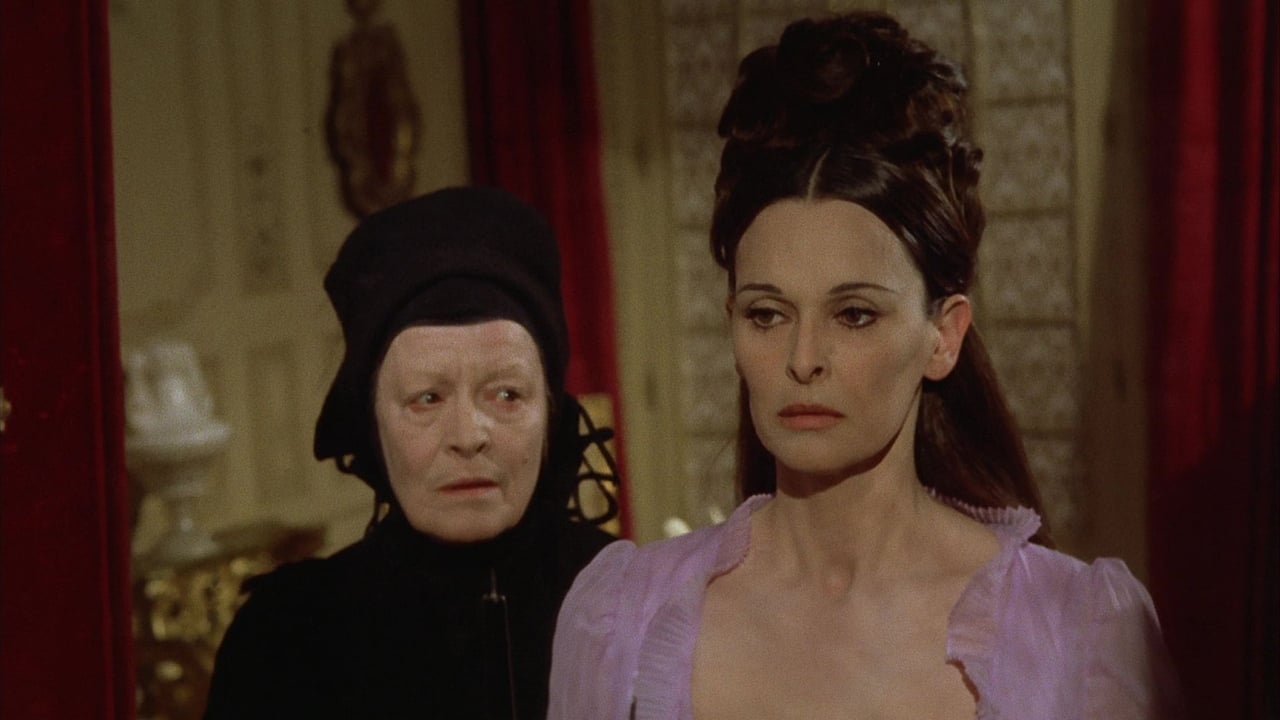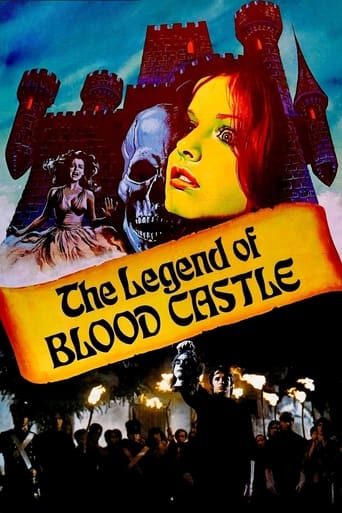

This is one of those films I said I would watch immediately upon acquiring (in view of its reputation) but only got to check out at a much later stage. Incidentally, I had agonized about whether to purchase the MYA DVD or not because it only featured the clothed Spanish print; eventually, I settled on a fuzzy-looking edition (with at least one noticeable audio drop-out) of the more explicit "International Version" accompanied by unremovable Finnish subtitles! Curiously enough, the copy I watched ran for 86 minutes though other sources claim its full-length as being 102! This is the fourth film I have watched revolving around the legend of Hungarian aristocrat Erzebet Bathory after Hammer's COUNTESS Dracula (1971; in which she was portrayed by the late Ingrid Pitt), Harry Kumel's modern-day rendition DAUGHTERS OF DARKNESS (1971; with Delphine Seyrig) and the third episode of Walerian Borowczyk's IMMORAL TALES (1974; with Paloma Picasso, Pablo's daughter!). I was let down by the Hammer version and, while I admire Borowczyk, the above-mentioned film was not one of his strongest; Kumel's is easily the best of the lot, though it is deemed too arty by some.To get back to Grau, I was very much impressed with BLOOD CEREMONY: it presents a reasonably authentic period and location sense (complemented by Carlo Savina's evocative score) but, more importantly, the plot holds the attention amid the expected violent/nude highlights. Interestingly, Lucia Bose''s Bathory here is not the historical one but rather a descendant of hers who, noticing her looks fading away, is persuaded by her devoted female servant to follow in her ancestor's footsteps; though the original Bathory was said to have killed hundreds of virgin girls and bathed in their blood to sustain her youth, we only get a handful of murders here (though they undeniably exude a kind of gruesome beauty) and, in a couple of cases, one seriously doubts their all-important virtuousness! The film puts forward a number of interesting embellishments to the familiar tale: there is a vampire plague before the protagonist even begins her depredations – though this is eventually revealed as a sham by the skeptical local doctor Silvano Tranquilli; still another 'undead' appears in the form of Bathory's own aristocratic companion – played by Espartaco Santoni (as in Grau's own previous effort, VIOLENT BLOOD BATH [1973], he cuts quite a dashing figure here) – whom she 'wills' into procuring her prey!; an unusual development, and possibly a first in the vampire subgenre, has Bose' being haunted by the decaying corpses of her victims; later still, after she catches Santoni being unfaithful with village beauty Ewa Aulin (this was a fine swan-song for the CANDY [1968] starlet, even if her own role was somewhat underwritten), she kills him and, while his corpse is being tried for his vampiric activities(amusingly presided over by a judge named Helsing!), she calmly confesses all and has no qualms about implicating her elderly accomplice as well!! Their subsequent punishment is quite harsh: the latter has her tongue sliced out, while both are walled up alive inside Bathory's mansion; by the way, the film features some gratuitous animal cruelty to boot (such as falcons chewing on live doves and truant children setting a bat bound to a tree on fire!).Surprisingly, Bose' flourished in this field during the decade – including another collaboration with Aulin, the underrated Giallo THE DOUBLE (1971); she is ideally cast here, though not quite as memorable as Seyrig had been (on a personal note, both actresses had worked for my favorite film-maker, Luis Bunuel, as did character actress Lola Gaos, here playing a sort of witch who advises Aulin on matters of love). The film is extremely well-made for a "Euro-Cult" product (though, again, it does not scale the classy heights of DAUGHTERS OF DARKNESS)...and I am not sure it is not actually superior to Grau's more renowned take on another much-abused monster, the zombie, in THE LIVING DEAD AT THE MANCHESTER MORGUE (1974)! Incidentally, that same year also saw the release of two other excellent Spanish horrors, namely Claudio Guerin Hill's A BELL FROM HELL (completed by Juan Antonio Bardem after the latter's mysterious death) and Bardem's own THE CORRUPTION OF CHRIS MILLER. As for Grau himself, I still have to catch up with his SUMMER NIGHT (1962), an award-winning drama with a good cast (including yet another Bunuel alumnus in Francisco Rabal!)...
... View MoreHere the infamous Elizabeth Bathory is aided by her husband Karl in acquiring virginal blood to help preserve her youth and beauty. Karl fakes his own death and masquerades as a vampire to fool the ignorant and superstitious villagers about who is real blood fiend is. There is an odd and uneasy alliance between Elizabeth and Karl, because Karl doesn't love Elizabeth, but rather it's his own sadistic indifference towards the mob which fuels his cruel abductions. Mean spirited and bleak, Grau's film treads the same Gothic landscape as Witchfinder General and Mark of the Devil, where the downtrodden are at the whim of the wealthy and powerful, preying on their fears and superstitions. Gothic horror fans will delight to the attention of realism and detail and perhaps it's total lack of camp, however this comes at a price as so much of it takes a serious approach that the shocking scenes happen matter of factually. It is paced rather slow, dreadfully so for modern viewers I might imagine.
... View MoreBlood Ceremony is another film based around the Elizabeth Bathory legend. Unfortunately, despite the fact that this legend makes for a great story and is one of the backbones of the horror genre's overall influence, there hasn't really been a good film about it; and Jorge Grau hasn't changed that with this film. I really hoped that this would be good and I wanted to like it as Blood Ceremony has a lot going for it in terms of atmosphere and set design, but the story really isn't strong enough to hold the audience's attention despite the fact that it features vampirism and a countess bathing in blood. As you would expect, the countess discovering that bathing in human blood makes up the backbone of this story, but there's also a vampire theme running throughout. This is brought directly into the story when the countess' husband plays into the villagers' fears of vampires by faking his own death in order to give himself cover to bring young women to wife, so she can preserve her beauty...The film is directed by Jorge Grau, who is of course most famous for his Video Nasty zombie flick masterpiece 'Let Sleeping Corpses Lie'. The two films have a great atmosphere in common and it's clear that this is important to the director. As you would expect given the plot line, the film features a fair amount of blood, which is good to see. The film's main contender is probably the Ingrid Pitt lead Hammer Horror film 'Countess Dracula', and comparisons are always likely to be made between the two. To be honest, while it was not Hammer's finest hour; I have to say that I preferred Countess Dracula, as it was overall the more interesting of the two films. Lucia Bosé is good in the lead role, though she doesn't really have the screen presence of Ingrid Pitt, which is another reason why I feel the Hammer film is the better of the two. Blood Ceremony is not really a bad film; the atmosphere is great and the film always looks nice; but for my money the plot didn't really work well and I found myself getting bored a couple of times too often. Could have been better!
... View MoreWhile by no means a classic, this slow-moving, but atmospheric Spanish/Italian co-production from director Jorge Grau (of LET SLEEPING CORPSES LIE fame) is at least a well-made and mature attempt at gothic horror.Lucia Bose (very good, considering the uneven English-language dubbing) stars as the legendary "Blood Countess" Erszebet Bathory, who killed "610 Nubile Virgins!" and bathed in their blood to stay eternally young... and to impress handsome nobleman Karl Zimmer (Espartaco Santoni), who seems more interested in bedding the innkeeper's daughter Marina (Ewa Aulin) than anything else. Zimmer eventually helps out the countess by seducing women, slitting their throats and letting the blood leak out through a hole to fill a bathtub downstairs. Of course, the townspeople eventually catch on, and the bad Countess finds herself in a Edgar Allan Poe-ish situation at the conclusion.I'd be lying if I said the film didn't lose me from time to time (American pre-released cutting may be the culprit), but it is still fairly interesting, has an authentic period setting (good sets, costumes, great-looking castles, lots of fog, etc) and is a bit more restrained (the most graphic gore is a scene when falcons eat another bird, which was probably real and not faked) than I expected. Worth a look, but I would give the Hammer film COUNTESS DRACULA (1970) with Ingrid Pitt the slight upper hand as far as Liz Bathory movies go. Score: 5 out of 10
... View More